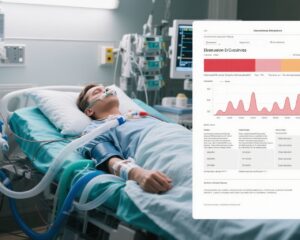Highlight
- Machine learning models using 12-lead ECG features effectively stratify long-term mortality risk in patients presenting with chest pain.
- Extra Survival Trees model outperformed traditional HEART score, significantly reducing missed events by over 90%.
- The model was externally validated in a large independent cohort, confirming its predictive accuracy across diverse patient groups.
- Potential to optimize clinical decision-making and resource allocation for patients suspected of acute coronary syndrome (ACS).
Study Background and Disease Burden
Chest pain is a common symptom leading to emergency department visits, with acute coronary syndrome (ACS) among the life-threatening causes requiring urgent evaluation. Early and precise risk stratification beyond acute diagnosis plays a crucial role in guiding subsequent treatment intensity and resource allocation. Current tools like the HEART score combine clinical, troponin, and ECG components but have limitations in sensitivity and specificity for mortality risk prediction. The wide availability and continuous use of 12-lead electrocardiography (ECG) in emergency settings provide a rich dataset for advanced analysis techniques, such as machine learning, which could enhance prognostication in suspected ACS patients. This approach may enable earlier identification of high-risk individuals who might benefit from intensified care, as well as safer discharge of low-risk patients.
Study Design
This prospective observational cohort study enrolled consecutive adult patients presenting with non-traumatic chest pain. The study cohort comprised 4015 patients with a mean age of 59 years, including 47% women. ECG data were extracted to define 73 morphological features per patient. These features served as input for six different machine learning models designed for survival analysis, with training performed on 80% of the data using 10-fold cross-validation and testing on the remaining 20%. Following algorithm optimization, a variational Bayesian Gaussian mixture model was applied to classify patients into distinct risk groups (low, moderate, high). The resulting model’s performance was compared against the established HEART score in predicting all-cause mortality, ascertained via multiple sources including the CDC National Death Index. External validation was conducted on an independent cohort of 3095 patients from a separate population.
Key Findings
Among the models tested, Extra Survival Trees demonstrated superior predictive performance. In the derivation cohort, the mortality rate was 20.3% over a median follow-up of 3.05 years. The model effectively categorized patients into low-, moderate-, and high-risk groups with significant survival differences (log-rank test statistic = 121.14, P < .001). Compared to the HEART score, it reduced the rate of missed fatal events by over 90%, achieving a negative predictive value of 93.4% and sensitivity of 85.9%, versus 89.0% and 75.0% respectively for HEART. This improvement suggests a more reliable identification of patients truly at risk. In the external cohort (mean age 59 years, 44% women, 30-day mortality 3.5%), moderate and high-risk groups displayed significantly elevated odds of mortality—3.62 (95% CI 1.35-9.74) and 6.12 (95% CI 2.38-15.75), respectively—compared to low-risk patients. These findings underscore the reproducibility and generalizability of the machine learning approach for mortality risk stratification.
Expert Commentary
The use of morphological ECG features in machine learning frameworks capitalizes on subtle cardiac electrical activity patterns not readily discernible by human interpretation alone. This study’s robust cohort size, prospective design, comprehensive follow-up, and external validation strengthen its clinical relevance. By outperforming the HEART score, the proposed model may offer a more precise risk assessment tool for clinicians managing suspected ACS, enabling personalized therapy intensity and judicious use of healthcare resources. However, adoption into routine clinical practice requires integration with clinical workflows, further validation in varied populations, and prospective outcome-based trials to evaluate impact on patient management and prognosis. Another limitation is that the model focuses on all-cause mortality rather than specific cardiovascular events, which may warrant further research. Mechanistically, nuanced ECG waveform patterns may reflect underlying myocardial ischemia or damage, arrhythmia propensity, or conduction abnormalities contributing to mortality risk.
Conclusion
This study demonstrates that a machine learning model using exclusively 12-lead ECG morphological features can effectively stratify mortality risk in patients presenting with chest pain, surpassing conventional clinical scoring systems like the HEART score. External validation ensures its applicability across different patient cohorts. This technological advance has promising implications for precision cardiovascular care, offering an accessible, rapid, and scalable tool to enhance risk prediction and support individualized clinical decision-making. Future research should focus on integration with multimodal diagnostic data, prospective clinical trials, and exploration of mechanistic links between ECG features and cardiac pathology to fully realize precision medicine in acute coronary syndrome management.
References
Bouzid Z, Sejdic E, Martin-Gill C, Faramand Z, Frisch S, Alrawashdeh M, Helman S, Gokhale TA, Riek NT, Kraevsky-Phillips K, Gregg RE, Sereika SM, Clermont G, Akcakaya M, Zègre-Hemsey JK, Saba S, Callaway CW, Al-Zaiti SS. Electrocardiogram-based machine learning for risk stratification of patients with suspected acute coronary syndrome. Eur Heart J. 2025 Mar 7;46(10):943-954. doi: 10.1093/eurheartj/ehae880. PMID: 39804231; PMCID: PMC11887543.



